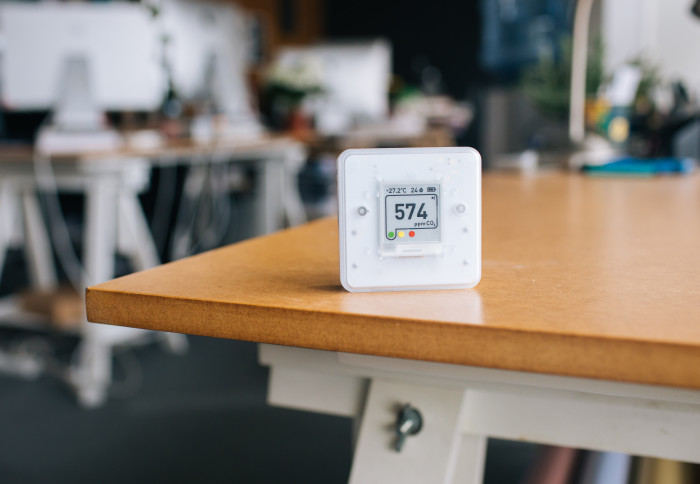CO2 monitoring recommended to manage COVID-19 spread in schools and offices

Scientists have created a new model for predicting COVID-19 infection risk in offices and classrooms, which uses CO2 to assess ventilation efficacy.
As more UK workers return to offices and normal schooling continues, a new paper published in the journal Indoor and Built Environment details a model that has been developed to predict the risk of airborne infection of COVID-19 in these environments as occupancy varies throughout the day.
Our model demonstrates that by managing the ventilation and occupancy levels of shared spaces we can manage the risk of airborne infection by a virus like SARS-CoV-2, which causes COVID-19. Dr Henry Burridge
The model – developed by researchers at Imperial College London, the University of Cambridge and the University of Leeds – uses monitored CO2 (carbon dioxide) and occupancy data to predict how many people are likely to be infected by an asymptomatic but infectious colleague.
We release CO2 when we breathe out, so higher levels of CO2 in a room are related to higher occupancy and lower ventilation. High levels of CO2 can therefore provide an important red flag to building managers to identify areas of inadequate ventilation.
Changes could then be made, for example to improve ventilation or change worker attendance patterns to reduce occupancy. The model shows that halving the occupancy of an office could reduce the risk of airborne transmission four-fold.
The importance of good ventilation
Lead author of the study Dr Henry Burridge, from the Department of Civil and Environmental Engineering at Imperial, said: “In shared spaces such as offices and classrooms, exposure to infectious airborne matter builds up over time, during which room occupancy may vary. By using carbon dioxide levels as a proxy for exhaled breath, our new model can assess the variable exposure risk as people come and go.
“Our work emphasises the importance of good ventilation in workplaces and in schools. The model demonstrates that by managing the ventilation and occupancy levels of shared spaces we can manage the risk of airborne infection by a virus like SARS-CoV-2, which causes COVID-19.”
While applications of the infection model so far have demonstrated that most workers in well ventilated open-plan offices are unlikely to infect each other via airborne particles, the risk becomes greater if the space is poorly ventilated or if the workers are involved in activities that require more speaking.
For instance, the model predicts each infected person could infect two to four others in an adequately ventilated but noisy call centre. Risks are also likely to increase if the infected individual is a ‘super spreader’.
No silver bullet
The study was jointly funded by the PROTECT COVID-19 National Core Study and UK Research and Innovation. The PROTECT study on transmission and environment is a UK-wide research programme improving understanding of how SARS-CoV-2 is transmitted from person to person, and how this varies in different settings and environments.
Professor Andrew Curran, Chief Scientific Adviser at the Health and Safety Executive and lead for the PROTECT study, added: “This important research demonstrates that, while the airborne transmission route can be a significant contributor to COVID-19 infection risk in places such as offices and schools, there are achievable steps that can be taken to reduce this risk and help facilitate a safe return.
"Ensuring adequate ventilation is a key element, and the appropriate use of tools such as CO2 monitoring can give building managers a much better understanding of their own ventilation systems and how they are performing for each activity undertaken in the space.
“However, the airborne route is just one of three known routes of transmission of the COVID-19 virus. Close-range person-to-person and surface transmission risks must also be assessed, and relevant measures applied to control all routes of exposure for all activities where risk is identified. For most businesses, a COVID-19 control strategy will involve a blended combination of measures identified through a risk assessment – there is no silver bullet.”
Professor Charlotte Deane, UKRI Director for the COVID-19 Response and Deputy Executive Chair of the Engineering and Physical Sciences Research Council, said: “A key challenge throughout the pandemic has been to understand how this novel virus is transmitted and to develop measures which could be implemented to curb the spread of infection.
"This study highlights that research and innovation supported by UKRI and the National Core Studies programme is continuing to evolve our understanding of the virus and helping us to develop knowledge which will be key to the global post-pandemic recovery.”
-
‘Predictive and retrospective modelling of airborne infection risk using monitored carbon dioxide’ by Henry C. Burridge, Shiwei Fan, Roderic L. Jones, Catherine J. Noakes and P. F. Linden is published in Indoor and Built Environment.
Article supporters
Article text (excluding photos or graphics) © Imperial College London.
Photos and graphics subject to third party copyright used with permission or © Imperial College London.
Reporter
Hayley Dunning
Communications Division